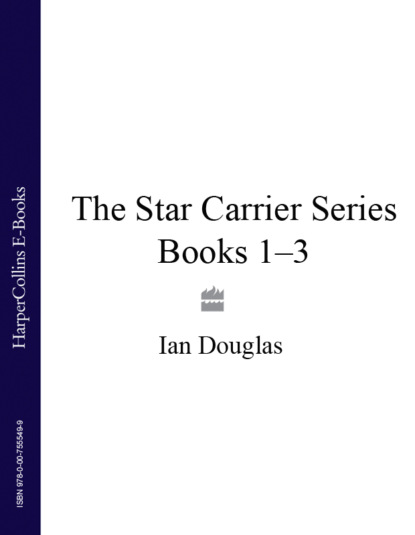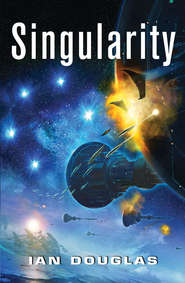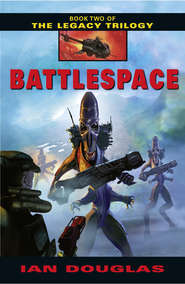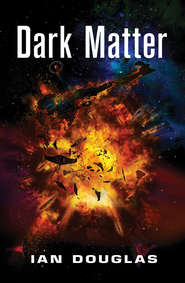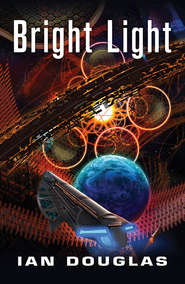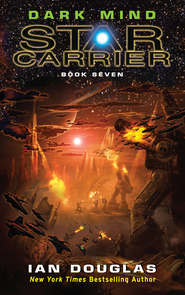По всем вопросам обращайтесь на: info@litportal.ru
(©) 2003-2024.
✖
The Star Carrier Series Books 1-3: Earth Strike, Centre of Gravity, Singularity
Настройки чтения
Размер шрифта
Высота строк
Поля
Another minute crawled past. Then, “Deceleration with strike package release in five … four … three … two … one … release. Commence deceleration.”
At the precisely calculated release point, a portion of the Starhawk’s outer hull turned liquid, flowed open, and exposed a teardrop-shaped missile nestled within. The fighter’s AI fired the missile, then triggered the spacetime-twisting immensity of the drive singularity, this time astern, off the Starhawk’s spiked tail. At fifty thousand gravities, the Starhawk began slowing; the strike package pod kept accelerating and, from the gravfighter’s perspective, flashed forward at five hundred kilometers per second squared, the dustcatcher winking out just long enough for the teardrop to flash past unimpeded, before switching on once more.
Ten seconds later, the gravfighter’s velocity had slowed by five thousand kilometers per second. After a minute, he was down to .87 of the speed of light, and his velocity continued to decrease.
Six hundred thousand kilometers ahead, the strike package, still accelerating and moving at better than .997 c, began to deploy.
At this point on the timeline, the Turusch at the planet half an AU up ahead would still be unaware that the Confederation task force had even arrived.
They were in for one hell of a surprise.
Tactician Emphatic Blossom at Dawn
Enforcer Radiant Severing
1241 hours, TFT
Emphatic Blossom at Dawn had been named for a species of hydrogen floater on the homeworld that stunned its prey with an electric charge fired through trailing, gelatinous tentacles … emphatic indeed. It was a tactician, and a gurgled suffix on the Turusch sound-pulse translated as “tactician” carried the added meaning of a deep tactician … very roughly the equivalent of a general or an admiral in the enemy’s fleet.
The phrase Emphatic Blossom at Dawn also implied stealth, relentless determination, and a sudden strike at the end, all qualities of mind that had contributed to its being designated a deep tactician.
There was little stealth involved in this operation, however. The enemy was hemmed in on the planet’s surface, huddled beneath its enclosing force-bubble as Turusch particle beams and thermonuclear warheads flared and thundered. For nearly thirty g’nyuu’m now, the Turusch fleet had been hammering that shield, and it was showing signs of imminent failure.
Victory was simply a matter of time.
“Tactician!” a communicator throbbed from a console-shelf overhead. “Enemy ships, range twelve thousand lurm’m!”
The news chilled … and excited. Emphatic Blossom had hoped the enemy would deploy its fleet. At that range, it would have taken light nearly five g’nyuu’m to reach the fleet’s sensors. And that meant—
“All vessels!” the Tactician pulsed. “Disengage from the enemy! Power deep! Ships in orbit, change vector now!”
Everything depended now on the Turusch hunterforce having the time to change course and speed. The enemy force would have launched their fighters within moments of dropping out of superluminal drive, which meant that those fighters, and any kinetic-kill devices they’d released along the way, would be just behind the light-speed wavefront bearing the news of the enemy’s arrival.
How fast were the approaching kinetic devices traveling, how close on the heels of light? How far behind them were the enemy fighters? That depended on the enemy’s technology—how fast they could accelerate—as well as on how quickly Turusch scanners had detected the enemy fleet in the first place. Five light-g’nyuu’m were a great depth. Many, many g’nya might have passed before Turusch scanners—or even the automated systems they controlled—had noticed the enemy’s arrival. How long had they been out there?
Blossom felt the kick of acceleration as the Turusch command hunter Extirpating Enigma increased speed, breaking free of synchronous orbit, and with it an answering surge of relief. If the enemy had targeted the Extirpating Enigma several g’nyurm ago, while still en route, their missiles would miss the command ship now.
Unfortunately, Emphatic Blossom’s warning would take time to reach the other ships. Some of them might detect the threat in time and act independently, but independence of action, independence of thought were decidedly not imperatives in Turusch tactical planning.
But it was vital that the command ship survive any opening kinetic barrage by the enemy. By boosting clear of a predictable orbit, they had—
“Enemy kinetic-kill missile has just passed our tail!” the scanner throbbed. “Speed—”
And then the Languid Depths of Time exploded in a white-hot glare of vaporizing metal.
In another instant, three other Turusch hunterships exploded, and two dazzlingly brilliant stars appeared against the surface of the planet, expanded, blossoming. The claw-transport Victorious Dream of Harmony staggered as a portion of its tail vanished in a flare of silent light, the shock setting the massive vessel into an uncontrolled tumble.
Lasered messages began flashing back to the flagship, speaking of projectiles passing through the fleet at speeds just a mr’uum less than that of light itself.
The hunters had just become the prey.
VFA-44 Dragonfires
Eta Boötis System
1245 hours, TFT
Gray’s Starhawk was still slowing swiftly, still traveling at nearly eighteen thousand kilometers per second—a mere 0.06 c, a snail’s pace compared to typical high-G transit speeds.
In principle, speed in combat was as important as it had ever been in the long-gone era of aerofighters and atmospheric dogfights in the skies above Earth. However, if your closing velocity was too high relative to your opponent, there simply wasn’t time to react, even with electronic senses and AI reaction times. The target was there and gone before you could do a thing about it.
The universe had minutes earlier slipped back into its more usual, low-velocity appearance. Eta Boötis, the star, glared dead ahead, smaller than Sol seen from Earth, but a hair brighter. Other stars gleamed in constellations distorted to Earth-born eyes; Arcturus was a golden beacon high and to the left relative to Gray’s current attitude.
Haris, the target planet, was a tiny crescent close by the star, 1.8 million kilometers distant, growing larger moment by moment.
At Gray’s command, the Starfighter began rearranging itself once again, adopting standard combat configuration—a blade-lean crescent, slender black wings drooping to either side of the thicker central body, the crescent tips stretched forward as if to embrace the enemy. Sleek streamlining wasn’t as necessary at these velocities as it was when plowing through near-vacuum at near-c, but there was always the possibility in these sorts of engagements that a fight would drop into planetary atmosphere, and then streamlining was very necessary indeed.
Minutes earlier, as he dropped past .5 c, Gray had released the dustcatcher, sending a microscopic speck of collected dust and hydrogen atoms compressed into a neutron micro-body hurtling ahead at half the sped of light. If it, by sheer, random chance, hit an enemy spacecraft as it zipped through the system, so much the better, but there was no way to aim it. Like the vaporized whiffs of any A7 strike packages that had missed their targets, the dust balls released by the infalling fighters would remain interstellar navigation hazards for eons to come.
Data flooded across Gray’s navigational and combat displays. As he glanced this across the screen, his in-head display opened windows, showing magnified views.
Expanding spheres of star-hot gas marked the funereal pyres of four Turusch ships, while a fifth tumbled end for end through space, spilling a haze of vaporized armor, internal atmosphere, and sparkling debris in its wake. Patches of bright-glowing turbulence on the planet’s night side showed where two A7s had missed orbital targets and struck the planet instead.
So … five hits total. Not bad, considering the Kentucky windage involved from sixth tenths of an AU out. That left fifty enemy vessels to deal with … correction, fifty-three. Three others must have either been masked by the planet when America had first scanned the inner system, or had arrived in the objective hours since.
Enemy warships were scattering from the vicinity of the planet, a swarm of nest-kicked hornets. Turusch vessels were characteristically large, bulky, and clumsy-looking, the space-going equivalents of fortresses painted in bold swaths of either green and black or a starker red and black. Even their fighters, painted in green-and-black stripes, had the look of lumpy potatoes, each four to five times the mass of a Confederation Starhawk.
Despite appearances, they were fast and they were deadly. Gray caught one huge capital ship with his eyes and held it as he triggered a weapons lock. The Starhawk’s offensive warload consisted of thirty-two VG-10 Krait smart missiles, a StellarDyne Blue Lightning PBP-2 particle beam projector, and, for very close work, a Gatling RFK-90 KK cannon. At long range, smart missiles were always the weapon of choice.
A tone sounded in his ear, indicating that a VG had acquired lock.
“Omega Seven!” he called over the tacnet. “Target lock! Fox One!”
The missile streaked from beneath the embrace of Gray’s wings, the heat dump from its miniature gravitic drive gleaming like a tiny sun as it streaked through space.
The other Starhawks were all there, still in the circle formation they’d adopted out in the system’s Kuiper Belt. The circle was opening now as the fighters applied lateral thrust and spread themselves apart. Other pilots were calling Fox One now, the code-phrase that meant they were firing smart missiles. More missiles flashed into the gulf ahead, tracking and dogging enemy warships, each accelerating at close to one thousand gravities.
His missile and two others were closing with the big green-and-black enemy warship—a Tango-class destroyer, under the standard Confederation nomenclature for enemy ships. The enemy was dumping sand—blasting clouds of tiny, refractive particles into space both to defeat laser targeting systems and to serve as a physical barrier against incoming kinetic-kill or high-velocity warheads.
One missile hit the expanding sand cloud and exploded, a ten-kiloton blast that pulsed in the darkness, but the other two missiles plunged through the hole vaporized in the Turusch ship’s defensive barrier, striking its magnetic shielding and detonating like a close pair of bright, savage novae.
Enemy shield technology was a bit better than the Confederation could manage yet. Neither nuke penetrated the envelope of twisted spacetime sheathing the destroyer, but enough of the double blast leaked through to crumple a portion of the warship’s aft hull. Atmosphere spilled into space as the ship slewed to one side, staggered by the hit.
Gray was already tracking another Turusch warship, however, a more distant one, a Juliet-class cruiser accelerating hard toward the planet.
“Omega Seven!” he called. “Target lock! Fox One … and Fox One!” Two Kraits streaked into darkness.
“Incoming, everyone,” Allyn warned. “Jink and pull gee!”





